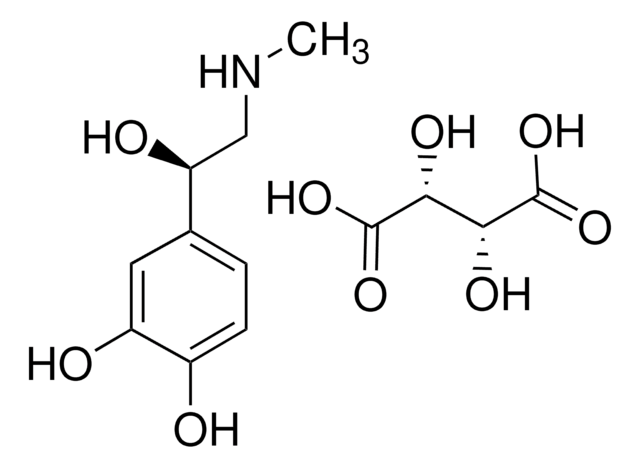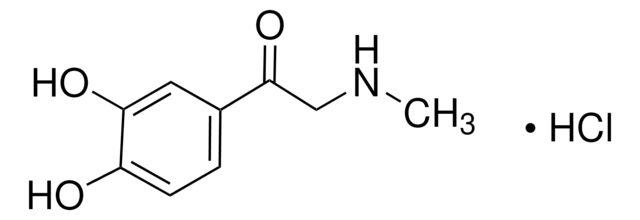Wichtige Dokumente
E4642
(±)-Epinephrine hydrochloride
≥98% (TLC), powder, adrenergic receptor agonist
Synonym(e):
(±)-Adrenalin, 4-(1-Hydroxy-2-[methylamino]ethyl)-1,2-benzenediol hydrochloride
About This Item
Empfohlene Produkte
Produktbezeichnung
(±)-Epinephrine hydrochloride,
Qualitätsniveau
Löslichkeit
H2O: 50 mg/mL
Lagertemp.
2-8°C
SMILES String
OC(CNC)C1=CC=C(O)C(O)=C1.Cl
InChI
1S/C9H13NO3.ClH/c1-10-5-9(13)6-2-3-7(11)8(12)4-6;/h2-4,9-13H,5H2,1H3;1H
InChIKey
ATADHKWKHYVBTJ-UHFFFAOYSA-N
Angaben zum Gen
human ... ADRA1A(148) , ADRA1B(147) , ADRA1D(146) , ADRA2A(150) , ADRA2B(151) , ADRA2C(152) , ADRB1(153) , ADRB2(154) , ADRB3(155)
Suchen Sie nach ähnlichen Produkten? Aufrufen Leitfaden zum Produktvergleich
Allgemeine Beschreibung
Anwendung
- in the induction of renalase expression in Human renal proximal tubular epithelial cells
- in the infusion studies to test its effect on heart rate and eye temperature measurements in bull
- as a medium supplement for the stimulation of endothelial progenitor cells
Biochem./physiol. Wirkung
Sonstige Hinweise
Signalwort
Danger
H-Sätze
Gefahreneinstufungen
Acute Tox. 3 Dermal - Acute Tox. 3 Oral - Eye Irrit. 2 - Skin Irrit. 2 - STOT SE 3
Zielorgane
Respiratory system
Lagerklassenschlüssel
6.1A - Combustible acute toxic Cat. 1 and 2 / very toxic hazardous materials
WGK
WGK 3
Flammpunkt (°F)
Not applicable
Flammpunkt (°C)
Not applicable
Persönliche Schutzausrüstung
Eyeshields, Faceshields, Gloves, type P2 (EN 143) respirator cartridges
Hier finden Sie alle aktuellen Versionen:
Besitzen Sie dieses Produkt bereits?
In der Dokumentenbibliothek finden Sie die Dokumentation zu den Produkten, die Sie kürzlich erworben haben.
Kunden haben sich ebenfalls angesehen
Unser Team von Wissenschaftlern verfügt über Erfahrung in allen Forschungsbereichen einschließlich Life Science, Materialwissenschaften, chemischer Synthese, Chromatographie, Analytik und vielen mehr..
Setzen Sie sich mit dem technischen Dienst in Verbindung.











